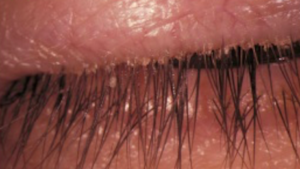Blepharitis 
Blepharitis is a condition that involves inflammation of the eyelids. This inflammation causes the eyelids to become red and irritated, with dandruff-like scales forming on the eyelashes. This condition is quite common among people of all ages.
Blepharitis is mainly caused by bacteria or an existing skin condition such as seborrheic dermatitis, ocular rosacea or psoriasis. Other causes include dry eyes, fungal eyelid infection, Meibomian gland dysfunction and parasites (Demodex eyelash mites). This condition is not contagious and does not cause irreversible damage to one’s eyesight. It is also treatable.
Blepharitis is classified into:
1. Anterior blepharitis: This type occurs where the eyelashes attach, at the outside front edge of the eyelids. It mainly occurs due to dandruff of the eyebrows/scalp (seborrheic blepharitis) or bacteria (staphylococcal blepharitis). Even though these bacteria are always present on the face and eyelids, their numbers may exceed, leading to an infection. In rare cases, this condition may be caused by allergies or a mite infestation.
2. Posterior blepharitis: This is where glands of the eyelids produce oil irregularly (Meibomian blepharitis). The irregular production of oil provides a favorable environment for the growth of bacteria. Posterior blepharitis can be as a result of skin conditions including scalp dandruff and acne rosacea.
Symptoms of blepharitis
There are many symptoms that point to the occurrence of blepharitis. These include:
• Irritation of the eyes and eyelids.
• Grittiness in the eyes.
• Watery eyes.
• Crusting of the eyelid/eyelashes.
How is blepharitis diagnosed?
If you experience any of the above symptoms, it is recommended to visit an Optometrist immediately. Your optometrist will carry out a full and comprehensive eye exam to determine if you have blepharitis or any other eye problem. Once it is established you have blepharitis, proper treatment will follow. Also, proper eye care is recommended to prevent the occurrence of blepharitis in the first place.
Treatment of blepharitis
Once you have been diagnosed with blepharitis, your optometrist will prescribe a treatment. Treatment of blepharitis mainly involves washing your eyes and performing warm compresses.
• Warm Compresses: To carry out these, you will need a washcloth and some warm water. Wet the washcloth with some warm water and wring the washcloth until it is somewhat dry. With your eyes closed, place the washcloth over your eyes for about a minute. This will cause the flakes stuck around your eyelashes to loosen and also prevent the clogging of nearby oil glands.
• Eyelid scrubs: For this, you will need a cotton swab, washcloth or lint-free pad and some warm water. Soak any of the above items in warm water and scrub the base of your eyelashes gently for about 15 seconds.
• Antibiotics: An antibiotic ointment may also be prescribed for your eyes. This ointment should be applied using a cotton swab or clean fingertip right before bedtime or as directed by your eye doctor. Also, an antibiotic medicine taken through the mouth may be prescribed.
• Eye drops: These may be used to reduce swelling, redness and dry eyes.
• Skin and eyelid hygiene: With proper eye care, it is possible to treat and prevent the occurrence of blepharitis. Ensure you wash your eyelashes with baby shampoo every day. Also, use antibacterial shampoo to wash your scalp, hair, and eyebrows.
To book your Comprehensive Eye Exam today call our Scarborough office to visit one of our optometrists.

Comments are closed.